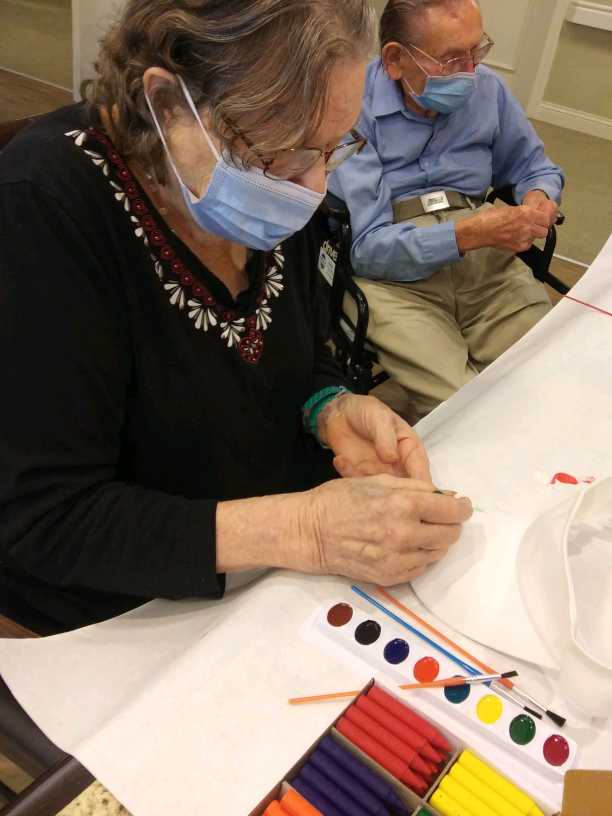Winning the Battle Against Loneliness
March 11, 2020
Five thoughtful design approaches to curb isolation, create connections in older adult communities
By Jami Mohlenkamp
“Health is a state of complete physical, mental and social well-being,” says the World Health Organization, “and not merely the absence of disease or infirmity.”
This statement is particularly resonant in the design of older adult communities, where feelings of isolation can be especially prevalent among residents. And as a growing body of scientific evidence suggests, social isolation can be more detrimental to human health than even obesity or smoking.
As an architect, one of my chief priorities in designing older adult communities is to create indoor and outdoor environments that counter feelings of isolation by fostering healthy connections between people, and with nature. These connections have the power not only to relieve residents’ sense of loneliness, but also to boost occupants’ memory and attention spans, recent research shows. For all the thought given to how built environments affect peoples’ physical health and wellness, what this research suggests, and what my own supports, is that equal consideration should be given to how the environments within older adult communities impact residents’ mental and emotional well-being.
The following design approaches give the mental and emotional facet of residents’ overall wellness the weight it deserves.
Designing to promote social connections. Viewing the indoor and outdoor common areas within older adult communities through a mental and emotional wellness lens uncovers a wide range of opportunities to incorporate elements that encourage socialization. Because so much activity at these communities tends to revolve around meals, dining facilities are a good starting point. More older adult communities are choosing an inclusive, blended approach to acuity-based dining by creating spaces where acuities are mixed rather than segregated, allowing assisted living and independent living residents to socialize before, during and after a meal.
To extend the social dining experience, communities can incorporate a bar or café adjacent to their dining spaces, locating it in a high-traffic area where residents (and their guests) are entering and exiting the dining venue to encourage chance meetings and socialization before and after meals. Another successful strategy is to design a feature such as a great room or other focal feature outside the dining area that will encourage residents to lounge while queuing for dinner or relaxing after a meal.
Creating inviting, readily accessible outdoor spaces is another way to foster the social connections that promote residents’ mental and emotional well-being. In designing these spaces, it’s important to consider how people are most comfortable interacting, with smaller, intimate nooks and pockets for quieter, smaller conversations as well as larger spaces to accommodate bigger group interactions.
The Airie 55+ community in Denver was designed with two courtyards, one with a pool that’s more activity-oriented and the other more garden-style for quieter interactions. Inside, Airie incorporates smaller second-floor social spaces that overlook the larger first-floor community room. Passive and active spaces that are within proximity to one another allow residents of all personalities to be able to watch or participate in the action.
Creating spaces and amenities that encourage visitors to come more frequently and stay longer. Thoughtfully designed spaces can become a magnet for residents and their friends and family members, particularly when they are intentionally located in the most desirable indoor and outdoor locations within a community, and where there are amenities that appeal to multiple generations of visitors. An outdoor playground or landscaped area designed for kids’ interaction and play encourages residents and their adult children to visit longer. Placing an interior space like a child’s playroom near a bistro area creates visual connection; the kids play in an area where the noise is contained so it’s not disruptive to other residents. These intentional adjacencies can lead to longer visits with older adult residents, expanding their connections with loved ones.
A thoughtfully designed dining experience can also encourage friends and family to extend their visits. Some communities are borrowing successful design approaches from restaurants, with open kitchens, food hall-style dining, cafés and other amenities that elevate the dining experience for residents and non-residents alike.
Designing to promote connections with nature. Connecting with nature is another powerful way to combat feelings of isolation. An older adult community can foster those connections by applying elements of biophilic design.
The Airie community includes courtyards with seating, activities, gardens, walking paths and direct access to one of the city’s largest lakes, while the sixth floor at Atria Englewood features outdoor terraces with unobstructed, panoramic views of the mountains. For assisted living residents with mobility challenges, the natural connections these accessible spaces foster are particularly important. Biophilic design also applies indoors, where abundant natural light, green walls, indoor gardens, water features and natural materials and elements can also create those connections .
Creating shared pets-and-people spaces. Interacting with animals has been shown to relieve stress and reduce feelings of isolation, which is one reason an estimated 75 percent of for-profit older adult residential communities allow residents to keep pets. Besides personal pets, many communities are designed to accommodate shared community pets, therapy animals, chicken coops and more. They make it work with an approach that accounts for safety, hygiene/cleanliness, ease of maintenance and accessibility. Thoughtful design can place units on the first floor for pet owners, with patio doors for direct access to the outside with their animals. Well-placed, dedicated outdoor spaces and relief areas for pets keeps smells away from entries and dining areas, while encouraging socialization among residents with pets.
Designing to promote connections with the surrounding community. Residents are more apt to thrive when they have a sense of independence and connection with the broader community. Thoughtful design can enable them to safely get out into the nearby community on foot, bike, golf cart, etc. With security for residents front of mind, inviting the broader community in for a dining experience, music performance or art display can also encourage the types of connections that the residents of older  adult communities ultimately depend on to thrive.
adult communities ultimately depend on to thrive.
About the Author: Jami Mohlenkamp is a principal at OZ Architecture and the leader of the firm’s senior living practice area. He will be speaking on the “Combating Social Isolation with Design” discussion panel at HEALTHTAC East 2020 to be held March 29-31 at Trump National Doral Miami.
